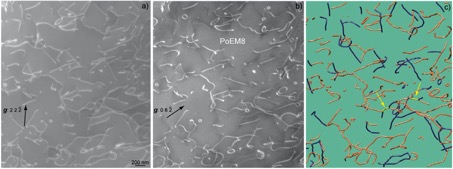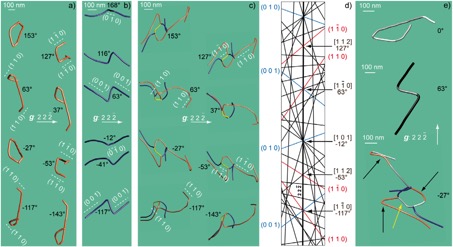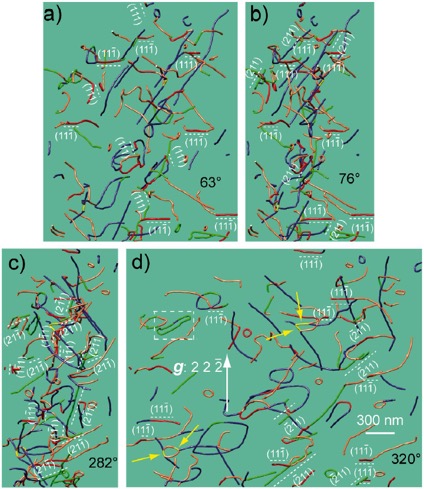RheoMan: un projet sur cinq ans, financé par l'ERC (Advanced Grant), visant à modéliser la rhéologie du manteau terrestre
Sep 14, 2017 Mécanismes de durcissement dans l'olivine Résultats
Dans une nouvelle publication qui vient de paraître en ligne dans Philosophical Magazine, Alexandre Mussi nous propose une nouvelle application de la tomographie électronique des dislocations qui permet, dans l'olivine, de décrypter des microstructures de dislocations particulièrement complexes afin de mettre en évidence les mécanismes responsable du durcissement observé.
This article describes the dislocation microstructure of an olivine single crystal deformed at 1090 °C. Characterizations have been performed by transmission electron tomography. The dislocation population is complex, composed of [001] and [100] dislocations with 3D configurations.

Figure 1: Typical PoEM8 microstructure: (a) WBDF micrograph obtained with the 2 2 -2 diffraction vector ([1 0 0] and [0 0 1] dislocations are in contrast); (b) WBDF micrograph obtained with g = 0 6 -2 on the same region as (a) (only [0 0 1] dislocations are in contrast); (c) Corresponding 3D reconstruction ([1 0 0], [0 0 1] and [1 0 -1] dislocations are shown in blue, orange and yellow colours, respectively), the two yellow arrows point out [1 0 -1] junctions.
Double cross-slip (sometimes associated with junctions) have been identified in this crystal.

Figure 2: Double cross-slip mechanism: (a) Reconstructed volume of a [0 0 1] dislocation obtained with g = 2 2 -2 (projected angle of −143°, −117°, −53°, −27°, 37°, 63°, 127° and 153°), the (1 1 0) planes are edge-on for the −117° and 63° tilt angles ([1 -1 0] zone axis) and the (1 -1 0) planes are edge-on for the −53° and 127° tilt angles ([1 1 2] zone axis); (b) Reconstructed volume of a [1 0 0] dislocation performed with the same diffraction vector as (a) (projected angle of −117°, −41°, −12°, 63°, 116° and 168°), the (0 0 1) planes are edge-on for the −117° and 63° tilt angles and the (0 1 0) planes are edge-on for the −12° and 168° tilt angles ([1 0 1] zone axis); (c) Complex dislocation configuration composed of a [1 0 0] and a [0 0 1] dislocation, a [1 0 -1] junction (yellow segment) and an attractive [0 0 1]/[1 0 0] dislocation crossed state; moreover a double cross-slip configuration of the [0 0 1] dislocation is revealed (same description as (a)); (d) Simulation of the Kikuchi lines, between −165° and 180°, in kinematic conditions; the (0 1 0) and (0 0 1) Kikuchi lines are shown in blue colour (in reference with the [1 0 0] dislocation in blue colour) and the (1 1 0) and (1 -1 0) Kikuchi lines are shown in red colour (in reference with the [0 0 1] dislocation in orange colour); (e) Summary of the three dislocation configurations in (a), (b) and (c) for tilt angles of 0°, 63° and −27°, respectively (the white dislocations segments designate the [0 0 1](1 1 0) slip systems, the light grey dislocations segments refer to the [0 0 1](1 -1 0) slip systems and the black dislocation segments designate the [1 0 0](0 0 1) slip systems), the yellow arrow points out a [1 0 -1] junction.
It is the first time that a quantitative study of climb systems has been performed thanks to electron tomography.

Figure 3: Dislocation climb planes (the dislocation segments which lie on the 1 planes are coloured in red and the dislocation segments are coloured in green for the 2 planes): (a) 3D reconstruction of a PoEM8 tilted series obtained with g = 2 2 -2, with a projected angle of 63° (the (1 1 -1) and (1 1 1) planes are edge-on with this projection condition); (b) Projection angle of 76° (the (1 1 -1) and (2 1 1) planes are edge-on along this direction); (c) 282° tilt angle (the (1 1 -1), (1 -1 1), (2 1 -1) and (2 -1 1) planes are edge-on with this orientation); (d) Projection angle of 320° (the (1 1 -1) and (-2 1 1) planes are edge-on with this projection condition), the white dashed square points out a break-up of a dislocation dipole by climb, the four yellow arrows point out [1 0 -1] junctions; The numerous dislocation segments which lie on the 1 and the 2 planes (19 segments in 1 and 23 segments in 2) show the occurrence of climb in PoEM8.
Finally, these interactions and mechanisms explain the strain hardening observed in the stress/strain compression curves of the crystal.
See the paper just published by our group:
A. Mussi, P. Cordier, S. Demouchy, B. Hue, "Hardening mechanisms in olivine single crystal deformed at 1090 °C: an electron tomography study". Philosophical Magazine (2017), doi:10.1080/14786435.2017.1367858

